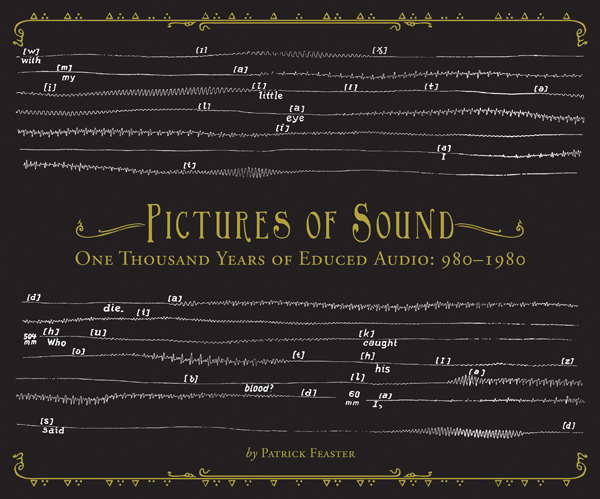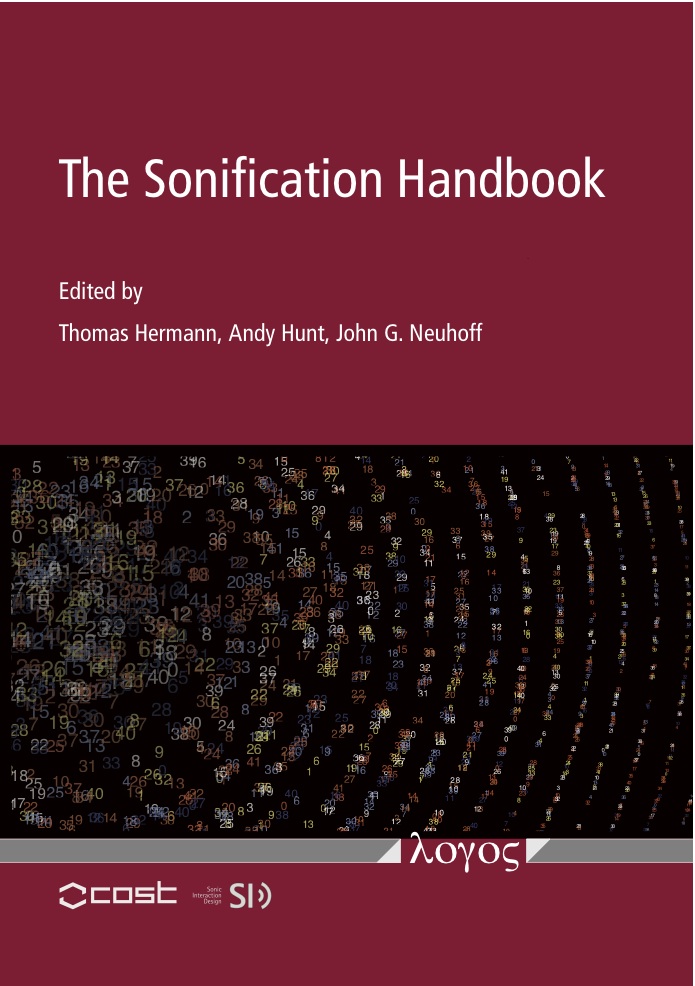Patrick Feaster: Pictures of Sound: One Thousand Years of Educed Audio, 980-1980 + CD (2012)
Filed under book, sound recording | Tags: · history of technology, media archeology, phonograph, sound, sound recording, technology

“Using modern technology, Patrick Feaster is on a mission to resurrect long-vanished voices and sounds—many of which were never intended to be revived.
Over the past thousand years, countless images have been created to depict sound in forms that theoretically could be “played” just as though they were modern sound recordings. Now, for the first time in history, this compilation uses innovative digital techniques to convert historic “pictures of sound” dating back as far as the Middle Ages directly into meaningful audio. It contains the world’s oldest known “sound recordings” in the sense of sound vibrations automatically recorded out of the air—the groundbreaking phonautograms recorded in Paris by Édouard-Léon Scott de Martinville in the 1850s and 1860s—as well as the oldest gramophone records available anywhere for listening today, including inventor Emile Berliner’s recitation of Der Handschuh, played back from an illustration in a magazine, which international news media recently proclaimed to be the oldest audible “record” in the tradition of 78s and vintage vinyl. Other highlights include the oldest known recording of identifiable words spoken in the English language (1878) and the world’s oldest surviving “trick recording” (1889). But Pictures of Sound pursues the thread even further into the past than that by “playing” everything from medieval music manuscripts to historic telegrams, and from seventeenth-century barrel organ programs to eighteenth-century “notations” of Shakespearean recitation.
In short, this isn’t just another collection of historical audio—it redefines what “historical audio” is.”
Publisher Dust-to-Digital, Atlanta/GA, 2012
144 pages, with 164 images
via prohairesis
Review: Randall Roberts (LA Times).
FirstSounds.org initiative
Patrick Feaster discusses Pictures of Sound (video, 36 min)
Author
Publisher
PDF, PDF (29 MB, updated on 2018-3-29)
ZIP (CD, 92 MB, ZIP’d OGG, updated on 2016-12-23)
Thomas Hermann, Andy Hunt, John G. Neuhoff (eds.): The Sonification Handbook (2011)
Filed under book | Tags: · human-computer interaction, sonification, sound, sound design, technology

This book is a comprehensive introductory presentation of the key research areas in the interdisciplinary fields of sonification and auditory display. Chapters are written by leading experts, providing a wide-ranging coverage of the central issues, and can be read from start to finish, or dipped into as required (like a smorgasbord menu).
Sonification conveys information by using non-speech sounds. To listen to data as sound and noise can be a surprising new experience with diverse applications ranging from novel interfaces for visually impaired people to data analysis problems in many scientific fields.
This book gives a solid introduction to the field of auditory display, the techniques for sonification, suitable technologies for developing sonification algorithms, and the most promising application areas. The book is accompanied by an online repository of sound examples.
Publisher Logos Publishing House, Berlin, 2011
OpenAccess book
ISBN 9783832528195
586 pages
via xgz
PDF (single PDF)
PDF (PDF articles, with audio samples)
Andrei Smirnov, Liubov Pchelkina: Generation Z: Russian Pioneers of Sound Art and Musical Technology in 1910-1930 (2011) [English/Hungarian]
Filed under booklet | Tags: · 1910s, 1920s, art, art history, avant-garde, music, music history, russia, sound, sound art, technology, utopia

Variophone, theremin terpsitone, rhythmicon, emiriton, ekvodin, graphical sound – just to mention a few of the amazing innovations of the beginning of the 20th century in Soviet Russia, a country and time turbulent with revolutions, wars and totalitarian dictatorship.
While the history of Russian post-revolutionary avant-garde art and music is fairly well documented, the inventions and discoveries, names and fates of researchers of sound, creators of musical machines and noise orchestras, founders of new musical technologies have been largely forgotten except, perhaps, Leon Theremin, inventor of the first electronic musical instrument, the theremin.
This community of creators, however, was inherently incompatible with the totalitarian state. By the late 1930s it became effectively written out of histories, wiped out from text books.
Many of their ideas and inventions, considered as utopian at that time, were decades later rein¬vented abroad. We still use them today not knowing their origin.
This booklet was produced for the Budapest edition of a traveling exhibition curated by Andrei Smirnov of the Theremin Center and Liubov Pchelkina of the State Tretyakov Gallery.
Publisher OSA Archivum, Budapest, 2011
ISBN 9789638853820
20 pages
exhibition (from the curators)
exhibition (gallery website)

